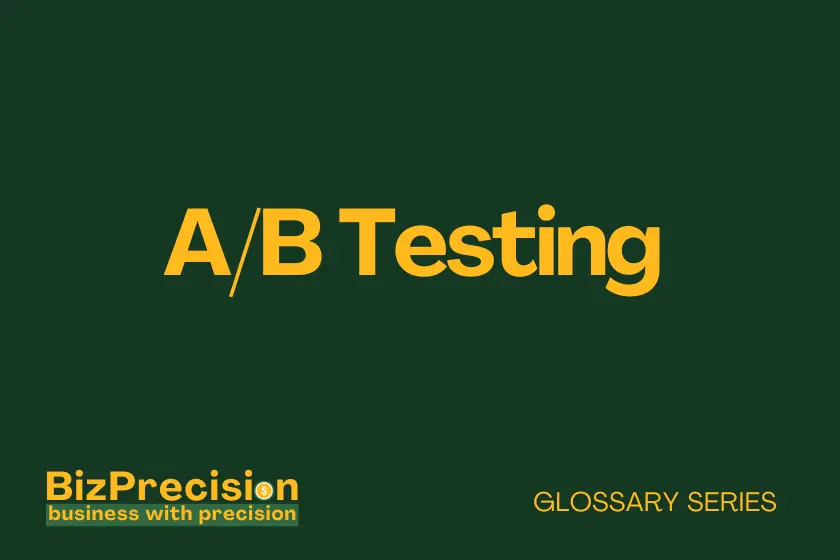What is A/B Testing?
A/B testing is a method of comparing two versions of a webpage or marketing asset to determine which performs better for a specific business goal.
Recent data shows the impact of A/B testing on business success. According to VWO’s Conversion Optimization Benchmark Report 2023, companies using A/B testing saw an average conversion rate increase of 22% across their digital assets.
Let’s explore how A/B testing can transform your business decisions from gut feelings into data-driven choices.
Understanding A/B Testing Fundamentals
How A/B Testing Works
A/B testing splits your audience into two groups. One group sees version A (the control), while the other sees version B (the variant). This simple process helps you make better choices.
The testing process follows these key steps:
- Form a hypothesis: Start with a clear goal in mind. For example, “Changing the button color to blue will increase clicks.” This helps shape your test design and keeps you focused on real results.
- Create two versions: Make one specific change between versions. If you change multiple elements, you won’t know which change caused the difference in results.
- Split traffic evenly: Your testing tool should randomly divide visitors between versions. This ensures fair results that you can trust.
Key Components of an A/B Test
Every successful A/B test needs these essential elements:
- Control Version: Your current design serves as the baseline. Think of it as your starting point for measuring improvement.
- Test Version: This is your new design with one key change. Keep it simple to get clear results you can act on.
- Sample Size: You need enough visitors to make your results meaningful. A good rule is at least 1,000 visitors per version.
Common A/B Testing Variables
Focus your tests on elements that impact user behavior:
- Call-to-Action Buttons: Test colors, text, size, and placement. HubSpot found that red buttons increased conversions by 21% compared to green in one test.
- Headlines: Try different approaches to grab attention. Make them clear and benefit-focused.
- Images: Test different types, sizes, and placements. Studies show that relevant images can boost engagement by up to 94%.
Statistical Significance in A/B Testing
Your results need to be trustworthy. Here’s what matters:
- Confidence Level: Aim for 95% confidence in your results. This means there’s only a 5% chance your results happened by chance.
- Duration: Run tests for at least two business cycles. This accounts for daily and weekly patterns in user behavior.
- Sample Size: Use a calculator to determine how many visitors you need. Small samples can lead to false conclusions.
Implementing Successful A/B Tests
Setting Up Your First A/B Test
Follow these steps for a successful first test:
- Choose the right page: Start with high-traffic pages. More visitors mean faster, more reliable results.
- Pick one element: Focus on a single change. Testing multiple changes makes it hard to know what worked.
- Set clear goals: Define what success looks like before you start. This could be more clicks, sign-ups, or sales.
Best Practices for A/B Testing
Make your tests more effective with these proven approaches:
- Test both pages at the same time: This prevents external factors from affecting your results.
- Don’t stop tests early: Even if you see good results, run the full test duration. Early results can be misleading.
- Document everything: Keep detailed records of your tests, including what worked and what didn’t.
Common A/B Testing Mistakes to Avoid
Learn from others’ mistakes to improve your results:
- Testing too many elements: This makes it impossible to know what caused the change. Stick to one variable at a time.
- Ignoring mobile users: Mobile traffic often behaves differently. Make sure your tests work well on all devices.
- Running tests for too short a time: Quick tests can give false results. Plan for at least two weeks of testing.
Tools and Platforms for A/B Testing
Choose the right tools for your needs:
- Google Optimize: Perfect for beginners. It’s free and integrates well with Google Analytics.
- VWO: Offers advanced features and easy-to-use visual editors. Great for growing businesses.
- Optimizely: Enterprise-level testing with powerful analytics. Best for large companies.
Measuring and Analyzing A/B Test Results
Key Performance Metrics
Focus on metrics that matter to your business goals:
- Conversion Rate: Track the percentage of visitors who take your desired action. Always compare this between versions to see real improvement.
- Bounce Rate: Monitor how many visitors leave without taking action. A lower bounce rate often signals better engagement.
- Time on Page: Measure how long visitors stay. Longer visits usually mean more engaged users.
Each metric tells part of your success story. Look at them together for the full picture.
Interpreting Test Data
Make sense of your results with these key steps:
- Check Statistical Significance: Your testing tool should tell you if results are significant. Don’t act on data that hasn’t reached 95% confidence.
- Look for Patterns: Study when and how visitors behave differently. Mobile users might prefer different designs than desktop users.
- Compare Segments: Break down results by user type. New visitors might react differently than returning customers.
Making Data-Driven Decisions
Turn your test results into smart business moves:
- Document Clear Winners: Keep detailed records of what worked. This helps you spot patterns over time.
- Share Results: Tell your team what you learned. Even “failed” tests teach valuable lessons about your users.
- Plan Next Steps: Use each test to guide your next one. Build on what works, and keep testing new ideas.
When to Stop an A/B Test
Know the right time to end your test:
- Reach Statistical Significance: Wait for 95% confidence in your results. This usually takes at least two weeks.
- See Clear Patterns: Look for steady results over time. Wild swings mean you need more testing.
- Hit Sample Size Goals: Make sure enough visitors have seen each version. Small samples can give false results.
Real-World Impact
A/B testing drives real business results. According to a recent study by Optimizely, companies that run regular A/B tests see an average revenue increase of 15% year over year.
Here’s what successful companies do:
- Test Regularly: Make testing part of your routine. Plan new tests based on what you learn.
- Start Small: Begin with simple changes like button colors or headlines. Build up to bigger tests as you learn.
- Keep Learning: Each test teaches you about your users. Use these lessons to make better business decisions.
Conclusion
A/B testing transforms guesswork into certainty. By comparing two versions of your digital assets, you can make choices based on real user behavior rather than opinions.
Take these steps to start testing today:
- Choose one element to test on your most important page
- Set up a free tool like Google Optimize
- Run your first test for at least two weeks
- Use what you learn to plan your next test
Remember, successful A/B testing isn’t about finding a “perfect” version. It’s about continuous improvement based on real data. Start small, test regularly, and let your users guide your decisions.
Ready to begin? Pick one element on your website to test today. Your first A/B test is the start of a more data-driven approach to business growth.







